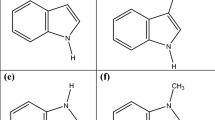Abstract
Ab initio quantum chemistry methods were applied to study the bifurcated bent hydrogen bonds Y··· H2CZ (Z = O, S, Se) and Y···H2CZ2 (Z = F, Cl, Br) (Y = Cl−, Br−) at the MP2/6-311++G(d,p) and MP2/6-311++G(2df,2p) levels. The results show that in each complex there are two equivalent blue-shifted H-bonds Y···H-C, and that the interaction energies and blue shifts are large, the energy of each Y···H-C H-bond is 15–27 kJ/mol, and Δr(CH) = −0.1 − −0.5 pm and Δv(CH) = 30 − 80 cm−1. The natural bond orbital analysis shows that these blue-shifted H-bonds are caused by three factors: large rehybridization; small direct intermolecular hyperconjugation and larger indirect intermolecular hyperconjugation; large decrease of intramolecular hyperconjugation. The topological analysis of electron density shows that in each complex there are three intermolecular critical points: there is one bond critical point between the acceptor atom Y and each hydrogen, and there is a ring critical point inside the tetragon YHCH, so these interactions are exactly H-bonding.
Similar content being viewed by others
References
Scheiner S. Hydrogen Bonding. New York: Oxford University Press, 1997
Jeffrey G A. An Introduction to Hydrogen Bonding. New York: Oxford University Press, 1997
Desiraju G R, Steiner T. The Weak Hydrogen Bond. Oxford: Oxford University Press, 1999
Hobza P, Havlas Z. Blue-shifting hydrogen bonds. Chem Rev, 2000, 100(11): 4253–4264
Alabugin IV, Manoharan M, Peabody S, Weinhold F. Electronic basis of improper hydrogen bonding: A subtle balance of hyperconjugation and rehybridization. J Am Chem Soc, 2003, 125(19): 5973–5987
Li A Y. Chemical origin of blue-and red-shifted hydrogen bonds: Intramolecular hyperconjugation and its coupling with intermolecular hyperconjugation. J Chem Phys, 2007, 126(15): 154102–154112
Rozas I, Alkorta I, Elguero J. Bifurcated hydrogen bonds: Three-centered interactions. J Phys Chem A, 1998, 102(48): 9925–9932
Li A Y. Theoretical investigation of hydrogen bonds between CO and HNF2, H2NF and HNO. J Phys Chem A, 2006, 110(37): 10805–10816
Frisch M J, Trucks G W, Schlegel H B, Scuseria G E, Robb M A, Cheeseman J R, Montgomery J A, Vreven Jr T, Kudin K N, Burant J C, Millam J M, Iyengar S S, Tomasi J, Barone V, Mennucci B, Cossi M, Scalmani G, Rega N, Petersson G A, Nakatsuji H, Hada M, Ehara M, Toyota K, Fukuda R, Hasegawa J, Ishida M, Nakajima T, Honda Y, Kitao O, Nakai H, Klene M, Li X, Knox J E, Hratchian H P, Cross J B, Adamo C, Jaramillo J, Gomperts R, Stratmann R E, Yazyev O, Austin A J, Cammi R, Pomelli C, Ochterski J W, Ayala P Y, Morokuma K, Voth G A, Salvador P, Dannenberg J J, Zakrzewski V G, Dapprich S, Daniels A D, Strain M C, Farkas O, Malick D K, Rabuck A D, Raghavachari K, Foresman J B, Ortiz J V, Cui Q, Baboul A G, Clifford S, Cioslowski J, Stefanov B B, Liu G, Liashenko A, Piskorz P, Komaromi I, Martin R L, Fox D J, Keith T, Al-Laham M A, Peng C Y, Nanayakkara A, Challacombe M, Gill P M W, Johnson B, Chen W, Wong M W, Gonzalez C, and Pople J A. Gaussian 03. Pittsburgh PA: Gaussian, Inc., 2003
Boys S F, Bernardi F. The calculation of small molecular interactions by the differences of separate total energies: Some procedures with reduced errors. Mol Phys, 1970, 19(4): 553–566
Bader R F W. Atoms in Molecules: A Quantum Theory. Oxford: Claerndon Press, 1990
Biegler-König F. Calculation of atomic integration data. J Comp Chem, 2000, 21(12): 1040–1048
Biegler-König F. Software news and updates: AIM2000 —A program to analyze and visualize atoms in molecules. J Comp Chem, 2001, 22(5): 545–559
Biegler-König F. Software news and updates: Update of the AIM2000-Program for atoms in molecules. J Comp Chem, 2001, 23(15): 1489–1494
Glendening E D, Badenhoop J K, Reed A E, Carpenter J E, Bohmann J A, Weinhold F. GenNBO5.0W, Theoretical Chemistry Institute, University of Wisconsin, Madison WI, 1996–2001
Tatamitani Y, Liu B, J. Shimada J, Ogata T, Ottavian P, Maris A, Caminati W, Alonso J L. Weak, improper, C—H···H—C hydrogen bonds in the dimethyl ether dimer. J Am Chem Soc, 2002, 124(11): 2739–2743
Koch U, Popelier P L A. Characterization of C-H-O hydreogen bonds on the basis of the charge density. J Phys Chem, 1995, 99(24): 9747–9754
Author information
Authors and Affiliations
Corresponding author
Rights and permissions
About this article
Cite this article
Li, A. Theoretical study of bifurcated bent blue-shifted hydrogen bonds CH2···Y. Sci. China Ser. B-Chem. 51, 623–631 (2008). https://doi.org/10.1007/s11426-008-0064-x
Received:
Accepted:
Published:
Issue Date:
DOI: https://doi.org/10.1007/s11426-008-0064-x




